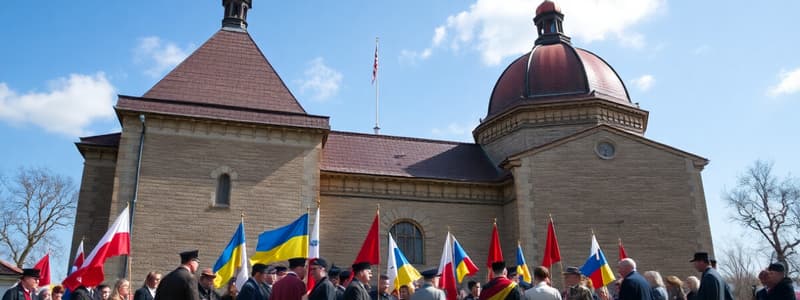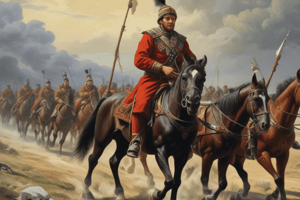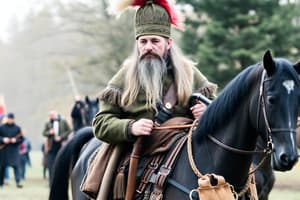Podcast
Questions and Answers
What actions did Ivan Samoilovych take to weaken Doroshenko's support?
What actions did Ivan Samoilovych take to weaken Doroshenko's support?
- He ordered the mass resettlement of Right-bank residents to the Left-bank. (correct)
- He allowed the Right-bank Cossacks to elect their own leaders.
- He formed an alliance with Doroshenko.
- He signed the Treaty of Buczacz.
What was the outcome of the Battle of Chigiryn in 1678?
What was the outcome of the Battle of Chigiryn in 1678?
- The Moscow army repelled the attack on Chigiryn. (correct)
- The Turkish army successfully captured Chigiryn.
- Yuri Khmelnytsky became the new hetman after the defeat.
- The Cossacks negotiated peace with the Turks.
Which treaty marked the end of the war for Ukraine between the Ottoman Empire, the Crimean Khanate, and Tsarist Russia?
Which treaty marked the end of the war for Ukraine between the Ottoman Empire, the Crimean Khanate, and Tsarist Russia?
- Eternal Peace Treaty
- Treaty of Bakhchisaray (correct)
- Konotop Articles
- Treaty of Buczacz
What area did the Ottoman Empire seize as a result of the Treaty of Bakhchisaray?
What area did the Ottoman Empire seize as a result of the Treaty of Bakhchisaray?
What was one of the primary demands made by the Cossacks regarding the future hetman?
What was one of the primary demands made by the Cossacks regarding the future hetman?
Who served as hetman for the longest duration during this period?
Who served as hetman for the longest duration during this period?
What event triggered a new Polish-Ottoman war during this period?
What event triggered a new Polish-Ottoman war during this period?
What was a significant consequence of the Ottoman army's actions in 1672?
What was a significant consequence of the Ottoman army's actions in 1672?
What major change occurred as a result of the Eternal Peace Treaty of 1686?
What major change occurred as a result of the Eternal Peace Treaty of 1686?
What was one consequence of Doroshenko's alliance with the Ottoman Empire?
What was one consequence of Doroshenko's alliance with the Ottoman Empire?
What significant political shift occurred in 1663 on the Right-bank Ukraine?
What significant political shift occurred in 1663 on the Right-bank Ukraine?
What action did Ivan Bryukhovetsky take to seek support in 1665?
What action did Ivan Bryukhovetsky take to seek support in 1665?
What was the outcome of Petro Doroshenko's attempt to unite the two banks of Ukraine?
What was the outcome of Petro Doroshenko's attempt to unite the two banks of Ukraine?
Which group did the local Cossack elite seek protection from in 1667?
Which group did the local Cossack elite seek protection from in 1667?
What event is associated with Ivan Sirko in 1667?
What event is associated with Ivan Sirko in 1667?
What happened to Demian Mnohohrishny in 1668?
What happened to Demian Mnohohrishny in 1668?
Why did Pavlo Teteria abdicate in 1665?
Why did Pavlo Teteria abdicate in 1665?
What was a major consequence of the Andrusovo Truce for Ivan Bryukhovetsky?
What was a major consequence of the Andrusovo Truce for Ivan Bryukhovetsky?
Flashcards
Division of the Hetmanate
Division of the Hetmanate
The division of the Hetmanate into Left-bank and Right-bank Ukraine, separated by the Dnieper River, occurred after the death of Bohdan Khmelnytsky.
Pavlo Teteria
Pavlo Teteria
Pavlo Teteria ruled Right-bank Ukraine for two years (1663-1665) and sought an alliance with Poland.
Ivan Bryukhovetsky
Ivan Bryukhovetsky
Ivan Bryukhovetsky, elected Hetman at the Black Rada, sought support from Moscow and signed the Moscow Articles, reducing the Hetmanate's autonomy.
Petro Doroshenko
Petro Doroshenko
Signup and view all the flashcards
Andrusovo Truce Impact
Andrusovo Truce Impact
Signup and view all the flashcards
Doroshenko's Crossing
Doroshenko's Crossing
Signup and view all the flashcards
Demian Mnohohrishny
Demian Mnohohrishny
Signup and view all the flashcards
Moscow Articles
Moscow Articles
Signup and view all the flashcards
Korsun Treaty
Korsun Treaty
Signup and view all the flashcards
Ivan Samoilovych
Ivan Samoilovych
Signup and view all the flashcards
Chigiryn
Chigiryn
Signup and view all the flashcards
Treaty of Buczacz
Treaty of Buczacz
Signup and view all the flashcards
Treaty of Bakhchisaray
Treaty of Bakhchisaray
Signup and view all the flashcards
Treaty of 'Eternal Peace'
Treaty of 'Eternal Peace'
Signup and view all the flashcards
General Military Council of Korsun
General Military Council of Korsun
Signup and view all the flashcards
Petro Sukhoviy
Petro Sukhoviy
Signup and view all the flashcards
Yuri Khmelnytsky
Yuri Khmelnytsky
Signup and view all the flashcards
Study Notes
The Division of the Hetmanate
- After the death of Bohdan Khmelnytsky, the Hetmanate was divided into Left-bank and Right-bank Ukraine by the Dnieper River.
- Reasons for the division included foreign interference, political and military conflicts, and the succession of various hetmans on both sides of the Dnieper during the 1660s and 1670s.
Right-bank Ukraine
- In 1663, after Yuri Khmelnytsky renounced the hetmanship, Pavlo Teteria became hetman of the Right-bank Ukraine.
- His reign lasted from 1663 to 1665.
- He favored alliance with Poland over Moscow.
- He supported the Polish campaign against Left-bank Ukraine in 1663-1664.
- He abdicated after a defeat and fled to Warsaw.
Left-bank Ukraine
- Ivan Bryukhovetsky was elected hetman at the Black Rada in Nizhyn in 1663.
- He lacked strong support among the Cossacks.
- He sought support from Moscow.
- In December 1665, he became the first hetman to travel to Moscow and signed the Moscow Articles, significantly reducing the Hetmanate's autonomy.
Right-bank Ukraine
- Petro Doroshenko became Hetman of Right-bank Ukraine in 1665.
- He aimed to unite Left-bank and Right-bank Ukraine.
- He pursued negotiations with the Ottoman Empire, continuing the policy of Bohdan Khmelnytsky.
- In December 1666, he defeated Polish forces in Podillia, sparking a new Cossack-Polish war.
- He lost allies after a Zaporozhian Cossack raid, led by Ivan Sirko, on the Perekop and North Crimea in 1667.
- The Crimean Khan signed a separate agreement with Poland in 1667, forcing Doroshenko to pledge allegiance to the Polish king.
Left-bank Ukraine
- News of the Andrusovo Truce in 1667 weakened Ivan Bryukhovetsky's authority in Left-bank Ukraine.
- Local Cossack elites, like Doroshenko, declared independence from both Moscow and Poland, seeking Ottoman protection.
Right-bank Ukraine
- In 1668, Doroshenko crossed the Dnieper to the Left-bank.
- Accounts differ on whether Doroshenko had Bryukhovetsky killed or if he was killed by Left-bank Cossacks.
- Doroshenko quickly returned to the Right-bank.
Left-bank Ukraine
- Demian Mnohohrishny, the Chernihiv Colonel, became the acting hetman of Left-bank Ukraine.
- Negotiations regarding his recognition as hetman continued through the fall of 1668.
- The Gluhiv Articles, signed by the end of 1668, confirmed his authority.
- He created company regiments (mercenary troops).
- He opposed the Andrusovo Truce and ensured Kyiv and its suburbs remained in Left-bank Ukraine.
- Cossack elites, dissatisfied with his independent policies, accused him of collaborating with Doroshenko and treason.
- He was captured, imprisoned, and sent to Moscow.
- Cossacks sent new electoral articles to Moscow, demanding restrictions on future hetmans' dealings with foreign powers, military court control over their actions, and exclusion of the Cossack population from future elections.
- These demands were incorporated into the Konotop Articles of 1672.
- Ivan Samoilovych, his co-conspirator and general scribe, was appointed hetman in 1672.
- He held the hetmanship for 15 years, longer than any other hetman of the period.
Right-bank Ukraine
- A military council, including Ottoman envoys, in March 1669, voted to recognize Ottoman suzerainty.
- The General Military Council in Korsun in March 1669 confirmed this alliance.
- The Korsun Treaty established the Zaporozhian Host as a state under the protection of Ottoman Sultan Mehmed IV.
- Doroshenko's popularity plummeted, leading to a hetman-ship contest between Petro Sukhoviy and Mykhaylo Khanenko.
- Doroshenko's five-year struggle against Khanenko resulted in significant losses.
- The acceptance of Ottoman protectorate triggered a new Polish-Ottoman war.
The Ottoman-Polish War
- The Ottoman army, led by Sultan Mehmed IV, crossed the Danube in June 1672.
- They captured the fortified city of Kamenets along with Cossack allies.
- In September, they besieged Lviv.
- Poland, facing formidable opponents, sought peace.
- The 1672 Treaty of Buczacz, disadvantageous to Poland, yielded:
- Podillia became Ottoman territory.
- Doroshenko gained control of Bracław and the southern part of the Kyiv Voivodeship.
- The Sultan received significant tribute.
- The Turkish victory further weakened Doroshenko.
- People fled to Left-bank Ukraine and the Slobozhanshchyna region.
The Struggle for the Right-bank Ukraine
- In January 1674, the Left-bank hetman, Ivan Samoilovych, and the Moscow army entered the Right-bank to confront Doroshenko, his Cossacks, and their Tatar and Ottoman allies.
- Between 1674-1675, the Bracław and Uman' regiments, and the Dnieper region experienced near depopulation.
- Samoilovych ordered the mass resettlement of Right-bank residents to the Left-bank to weaken Doroshenko's support.
- Doroshenko surrendered in September 1676.
- The Turks appointed Yuri Khmelnytsky as hetman.
- In 1677, the first Ottoman-Tatar campaign against the Cossack stronghold of Chigiryn began.
- However, the Moscow army repelled the attack.
- During a second siege in 1678, Chigiryn was destroyed.
- To prevent Turkish advances into Left-bank Ukraine and strengthen Khmelnytsky’s position, Samoilovych forced further Right-bank resettlement, leading to the desolation of central and southern Kyivshchyna.
Conclusion
- The conflict between the Ottoman Empire, Crimean Khanate, and Tsarist Russia ended with the Treaty of Bakhchisaray in January 1681.
- The Dnieper River became the new boundary.
- The Ottoman Empire obtained North Kyivshchyna, Bracław, and Podillia.
- Tsarist Russia gained Left-bank Ukraine and Kyiv.
- South Kyivshchyna and Bracław remained unpopulated for twenty years.
- The Ottoman army suffered a decisive defeat at Vienna in 1683.
- Poland captured significant portions of Right-bank Ukraine.
- The 1686 "Eternal Peace" Treaty between Poland and Russia divided the Hetmanate:
- Left-bank Ukraine, Kyiv, Zaporozhian Sich, and Chernihiv-Sivershchyna became Russian territories.
- Poland ceded claims to Kyiv in exchange for compensation.
- Bracław and South Kyivshchyna remained a neutral, unoccupied zone between the two states.
- North Kyivshchyna, Volhynia, and Galicia returned to Poland.
- Podillia remained Ottoman until 1699, when it joined the Polish-Lithuanian Commonwealth.
Studying That Suits You
Use AI to generate personalized quizzes and flashcards to suit your learning preferences.




